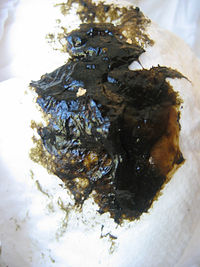
Photo from wikipedia
526 Effect of meconium stained amniotic fluid on perinatal outcome in preterm premature rupture of membranes Avital Wertheimer, Eran Hadar, Rony Chen, Arnon Wiznitzer, Eyal Krispin Helen Schneider Hospital for… Click to show full abstract
526 Effect of meconium stained amniotic fluid on perinatal outcome in preterm premature rupture of membranes Avital Wertheimer, Eran Hadar, Rony Chen, Arnon Wiznitzer, Eyal Krispin Helen Schneider Hospital for Women, Rabin Medical Center, Petach Tikva, Petach Tikva, Israel, The Sackler Faculty of Medicine, Tel Aviv, Tel Aviv, Israel OBJECTIVE: To determine whether meconium-stained amniotic fluid (MSAF) encountered in pregnancies complicated by preterm premature rupture of membranes (PPROM) is associated with adverse perinatal outcome. STUDY DESIGN: A retrospective cohort study reviewing delivery files of all pregnancies with PPROM and MSAF during labor who delivered in a tertiary hospital at 24 to 36(+6) weeks of gestation between 2007 and 2017. The study group consisted of 87 PPROMMSAF deliveries (cases) that were matched to 261 deliveries with clear amniotic fluid PPROM based on age, number of fetuses, gravidity, parity and week of delivery (controls). The association of amniotic fluid type with pregnancy outcome was examined. Neonatal respiratory morbidity was defined as the presence of any of the following: respiratory distress syndrome, transient tachypnea of the newborn, meconium aspiration syndrome, or need for ventilatory support. RESULTS: Baseline characteristics were similar in cases and controls except for a lower prevalence of preeclampsia in the controls group (0.4% vs. 5.8%, p1⁄40.004) (table 1). Compared with the controls PPROM-MSAF deliveries were associated with hospitalization in neonatal intensive care unit (NICU) (62.1% vs. 45.6%, p1⁄40.023), intraventricular hemorrhage (IVH) (12.6% vs. 5.8%, p1⁄40.05), mechanical ventilation (25.3% vs. 14.2%, p1⁄40.02), meconium aspiration (3.8% vs. 0%, p1⁄40.015) and neonatal respiratory morbidity (36.8% vs. 23.8%, p1⁄40.02) (Table 2). Multivariable analysis adjusted for age, gravidity, parity, mode of delivery and preeclampsia demonstrated that PPROM-MSAF pregnancies were independently associated with an increased risk for neonatal respiratory morbidities (estimate OR1⁄41.87, p1⁄40.018). CONCLUSION: MSAF is associated with higher prevalence of adverse perinatal outcome when compared to clear amniotic fluid in pregnancies complicated by PPROM. Meticulous feto-maternal monitoring is required in those cases with a lower threshold for intervention.
Journal Title: American Journal of Obstetrics and Gynecology
Year Published: 2019
Link to full text (if available)
Share on Social Media: Sign Up to like & get
recommendations!